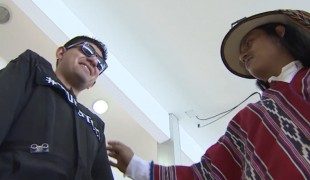- 12571
- 685
- 19
- 16
- 0
- Help Ukraine
About the solution
That’s why he set out to create a discrete device, so they feel more comfortable and that’s how the shoe came.
The shoe has three ultrasound sensors placed inside the sole – in the frontal, lateral, and back areas. The sensors emit ultrasound waves, which are reflected by surrounding objects and come back to the sensor. The shoe vibrates depending on the distance and position of the objects. The shoe is battery-powered and detects objects of all kinds: Plastic, concrete, metal, marble, wood, fabric, glass, person, door beams, animals, cars, beds, trees, etc. within a 25-inch (63.5 centimeter) radius of the wearer.
The device can be recharged with a USB port via computer or with a cell phone charger. It takes about five hours to fully charge, and it’s good for three to four days.
Adapted from: http://bit.ly/1uBMP8y
https://www.youtube.com/watch?v=9WZpSCfDYNg
This solution shall not include mention to the use of drugs, chemicals or biologicals (including food); invasive devices; offensive, commercial or inherently dangerous content. This solution was not medically validated. Proceed with caution! If you have any doubts, please consult with a health professional.
DISCLAIMER: This story was written by someone who is not the author of the solution, therefore please be advised that, although it was written with the utmost respect for the innovation and the innovator, there can be some incorrect statements. If you find any errors please contact the patient Innovation team via info@patient-innovation.com
-
-
368
-
0
-
4417

Collaborator Pierluigi Mantovani creates Evolution Devices - solutions that aim to transform Multiple Sclerosis Management
CAREGIVING
BODY BALANCE: Maintaining body balance
STANDING UP: Standing up from a seated position
WALKING: Walking
Multiple Sclerosis
Assistive Daily Life Device (to help ADL)
Walking Aid (wheelchair/walker/crutches)
App (Including when connected with wearable)
AI algorithm
Body-Worn solutions (Clothing, accessories, shoes, sensors...)
Restoring mobility
Regaining sensory function
Managing pain
Promoting self-management
Preserving Organ Function
Managing Neurological Disorders
Maintaining Balance and Mobility
To improve Treatment/Therapy
Preventing (Vaccination, Protection, Falls, Research/Mapping)
Raise awareness
Caregiving Support
General and Family Medicine
Internal Medicine
Medical Genetics
Neurology
Physical Medicine and Rehabilitation
United States
-
-
-
351
-
0
-
3942

Student creates suit for the blind
WALKING: Walking
Blindness
Body-Worn solutions (Clothing, accessories, shoes, sensors...)
Vision problems
Restoring mobility
Promoting self-management
Managing Neurological Disorders
Promoting inclusivity and social integration
Maintaining Balance and Mobility
Preventing (Vaccination, Protection, Falls, Research/Mapping)
Raise awareness
Caregiving Support
General and Family Medicine
Neurology
Ophthalmology
Ecuador
-
-
-
421
-
0
-
6311

Parents bring together experts to create smart glasses for their son suffering from low vision
COMMUNICATION: Communicating, whether by speaking, listening, or other means
CAREGIVING
WALKING: Walking
Urban exploration
Tunnel Vision
5 Senses support devices: (glasses, hearing aids, headphones...)
Assistive Daily Life Device (to help ADL)
Vision problems
Regaining sensory function
Promoting self-management
Preventing (Vaccination, Protection, Falls, Research/Mapping)
Caregiving Support
Neurology
Ophthalmology
Pediatrics
Spain
-
 en
en